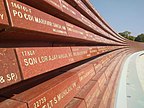
Back জাতীয় যুদ্ধ স্মৃতিসৌধ (ভারত) Bengali/Bangla אנדרטת המלחמה הלאומית (הודו) HE राष्ट्रीय समर स्मारक (भारत) Hindi राष्ट्रीय युद्ध स्मारक (भारत) Marathi ਰਾਸ਼ਟਰੀ ਯੁੱਧ ਸਮਾਰਕ (ਭਾਰਤ) Punjabi தேசிய போர் நினைவுச்சின்னம் (இந்தியா) Tamil జాతీయ యుద్ధ స్మారకం Tegulu قومی جنگ یادگار (بھارت) Urdu
| National War Memorial | |
|---|---|
Rāṣhṭrīya Samara Smāraka | |
Clockwise from top: The Stambh (obelisk) houses the immortal flame, A section of the Tyag Chakra, View of a bust at the Param Vir Chakra section | |
| For Indian military dead of all wars | |
| Established | 2019 |
| Unveiled | 25 February 2019 |
| Location | 28°36′46″N 77°13′59″E / 28.612772°N 77.233053°E C Hexagon, India Gate Circle, New Delhi, India |
| Designed by | Yogesh Chandrahasan[1] |
| Statistics source: Official government website | |
The National War Memorial (ISO: Rāṣhṭrīya Samara Smāraka ; Hindi pronunciation: [raːʂʈriːjə səmərə smaːrəkə]) is a war memorial in New Delhi, Delhi, India, located at India Gate Circle. It has been built to honour and remember soldiers of the Indian Armed Forces who fought in armed conflicts of independent India. The names of armed forces personnel martyed during the armed conflicts with Pakistan and China as well as the 1961 War in Goa, Operation Pawan, and other operations such as Operation Rakshak are inscribed on the memorial walls in golden letters.[4]
This monument is spread over 40 acres of land and was built by the Government of India around the existing chhatri (canopy), near India Gate, New Delhi.[5] The memorial wall is flushed with the ground and in harmony with existing aesthetics.[6] It was completed in January 2019 and unveiled on 25 February 2019 in an inauguration ceremony held at the monument where Prime Minister of India Narendra Modi in the presence of Chief of Defence Staff (CDS) of India, and the three Chief of Staffs of the Indian Armed Forces, ignited the eternal flame of the Amar Jawan Jyoti (Flames of Eternal Soldiers) at the Amar Chakra under the main obelisk of the monument.[7]
The old Amar Jawan Jyoti, located at India Gate, previously served as the national war memorial. It was constructed in a short time frame following the Indo-Pakistani War of 1971 as per Prime Minister Indira Gandhi's wishes, so that it could be inaugurated on 26 January 1972 as a mark of respect to the martyrs of the war.[8][9][10] The flame from here was merged with the flame at the new National War Memorial on 21 January 2022 by Integrated Defence Staff chief Air Marshal Balabhadhra Radha Krishna.[11]
- ^ Cite error: The named reference
:designerswas invoked but never defined (see the help page). - ^ "शहीदों के सम्मान पर 1916 में लिखी यह कविता आज भी मौजूं है". Aaj Tak आज तक (in Hindi). 15 February 2019. Retrieved 3 January 2021.
- ^ "National War Memorial". nationalwarmemorial.gov.in. Archived from the original on 31 March 2020. Retrieved 3 January 2021.
- ^ Pandit, Rajat (1 January 2019). "Delhi: War memorial ready, 60 years after it was first proposed". The Times of India. Archived from the original on 3 January 2019. Retrieved 30 January 2019.
- ^ Baruah, Sukrita (26 February 2019). "Explained: India's National War Memorial". The Indian Express. Retrieved 2 March 2019.
- ^ Gokhale, Nitin A. (11 July 2014). "Fulfilling a sacred contract with the soldier". News Warrior. Retrieved 28 August 2014.
- ^ "PM Modi inaugurates National War Memorial in New Delhi". The Hindu. PTI. 25 February 2019. ISSN 0971-751X. Retrieved 14 December 2020.
- ^ Chhina, Last Post. Indian War Memorials Around the World (2014), pp. 161.
- ^ Anand, Col Rohan (January 2016). "National War Memorial, At Last". Sainik Samachar. Retrieved 23 January 2022.
- ^ Anand, Col Rohan (May 2015). "India Gate. An Indian Legacy". Sainik Samachar. Retrieved 23 January 2022.
- ^ Bose, Joydeep (21 January 2022). "In historic move, Amar Jawan Jyoti merged with National War Memorial flame". Hindustan Times. Retrieved 23 January 2022.



